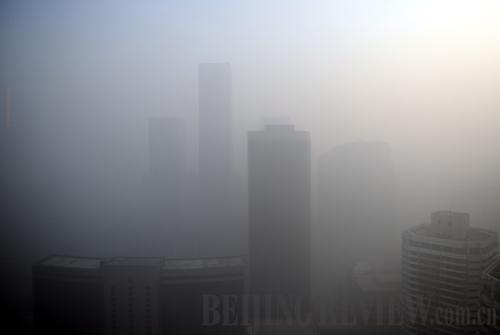Law amendment urged to combat air pollution
- By Jiao Meng
 0 Comment(s)
0 Comment(s) Print
Print E-mail China.org.cn, February 22, 2013
E-mail China.org.cn, February 22, 2013
 |
|
Guomao area near Beijing's Eastern 3rd Ring Road is enveloped with heavy smog on January 12. |
Higher standard to clean air
The revised air quality standard includes index PM2.5, and will be implemented nationwide by January 1, 2016, Xinhua reported.
The government monitors PM2.5 in four municipalities, 27 provincial capitals and three key regions -- east China's Yangtze River Delta, south China's Pearl River Delta and the northern Beijing-Tianjin-Hebei area beginning last year.
Mr. Chai believes that this new standard also brings more challenges. "Air quality in over 80 percent of China’s 118 major cities holds to the old standard," he said. "The situation is grim."
Mr. Chai believes that this law should play a greater role in ensuring people’s good health from pollution as well as safeguarding their environmental rights.
More expectations
Professor Hao proposed in a report that an independent bureau should be established to manage air quality issues, similar in scope to the National Nuclear Safety Administration.
"There are many departments involved in this field. What we need is to deal with this problem more effectively and collectively," he said. "We should attach the same level of importance to air pollution as nuclear safety."
"The latest statistics from the Beijing Health Bureau show that lung cancer morbidity rates have surged 56 percent between 2001 and 2010 in Beijing. Air pollution is one of the primary causes. A sound and powerful law will showcase government’s sincere heart to protect air and environment," wrote an editorial from the Beijing News newspaper.
Background information: Top 10 legislative highlights
1. Basic goal: Improve air quality levels to protect people’s health
2. Forecast, early warning and emergency measures of heavy pollution incidents
3. Regional joint prevention and control mechanism will be settled through legal channels
4. Multi-pollutant coordinating control will combat complex air pollution problems
5. Supervision and assessment mechanisms of local government’s responsibility in air pollution control will be settled; environmental quality will be added as a standard to assess local officials.
6. Total Emission Control is bound to be extended from two control zones (zones designated by the State Council for the control of acid rain and sulfur dioxide) to nationwide with more targeted pollutants.
7. No pollutant emissions will be allowed without air pollution permits.
8. Tougher rules on mobile source pollution, including higher fuel quality, in-use vehicle environmental protection logo, etc, securing MEP’s bigger say in rule making.
9. Toxic and harmful gas will be included.
10. Stiffer punishment for law violations: revise regulations on maximum fines regarding air pollution accidents from 500,000 yuan (US$ 80,100) to no upper limit.





